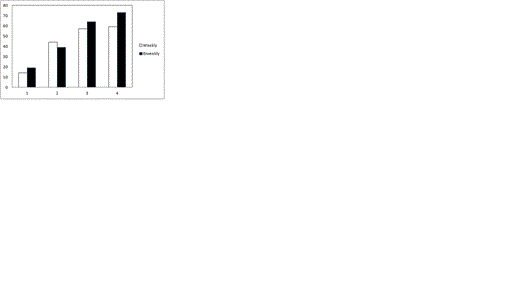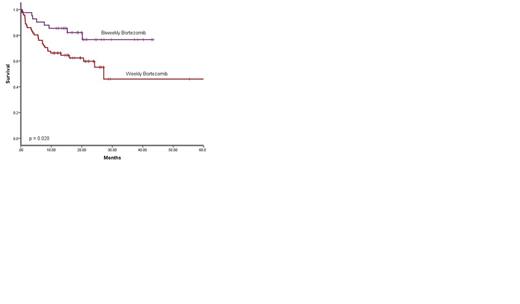Abstract
Bortezomib based chemotherapy (especially cyclophosphamide-bortezomib-dexamethasone – CVD) has been increasingly adopted as front line therapy for treatment of patients with systemic AL amyloidosis. The phase II prospective study of single agent Bortezomib in relapsed setting, suggested both once weekly or biweekly Bortezomib are equally effective. Based on a risk adapted model, in the UK, weekly Bortezomib (usually as part of CVD) is often used to reduce toxicity and improve tolerability. We report the outcomes of 115 patients diagnosed with systemic AL amyloidosis at the National Amyloidosis centre between 2010-2012 followed up prospectively as a part of the ALChemy observational study and received Bortezomib based first line therapy either on biweekly or weekly regimens. 75% of these patients had cardiac involvement and 73% renal involvement. Haematological response and survival were analysed in the context of Bortezomib regimen used. Further analysis was also performed in patients matched for cardiac staging.
79% patients received CVD regime and 82% had Dexamethasone with their Bortezomib. Response and survival data was available on all 115 patients; 3 patients lacking dosing details were excluded from the dosing analysis. 89% had measurable disease for response assessment analysis. 63% patients had once and 37% had twice weekly Bortezomib. 74% of patient received their Bortezomib intravenously and 26% subcutaneously. 17% of patients had only received a maximum of 1 cycle of which 58% (10% of total cohort) had died within 4 weeks of commencing chemotherapy.
For patients who were matched for mayo cardiac stage (n=38 in each group), the median OS was not reached in either group. The overall survival was superior in the group receiving the biweekly regimen with survival at 2 and 4 years of 78% (both) compared to 72% and 55% in the weekly group. In the matched group, patients with Mayo stage 3 disease (n=15 in each group) had not reached their median OS when receiving biweekly regimen but those who received weekly regimen had a median OS of 27.2 months (p=0.574). On a multivariate analysis, NT-proBNP >8500ng/L remained the only statistically significant prognostic factor.
In summary, patients treated with biweekly Bortezomib regimen appear to have a 20% higher rate of achieving a VGPR or better and have a superior overall survival compared to those treated on the less intensive weekly regimen. Better criteria for patient selection are needed to allow more patients to receive Bortezomib on the more potent biweekly regimen at least for the first three cycles to achieve a rapid deep clonal response.
Wechalekar:Jansen Cilag: Honoraria.
Author notes
Asterisk with author names denotes non-ASH members.



This feature is available to Subscribers Only
Sign In or Create an Account Close Modal